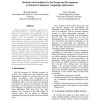Free Online Productivity Tools
i2Speak
i2Symbol
i2OCR
iTex2Img
iWeb2Print
iWeb2Shot
i2Type
iPdf2Split
iPdf2Merge
i2Bopomofo
i2Arabic
i2Style
i2Image
i2PDF
iLatex2Rtf
Sci2ools
SAC
2006
ACM
2006
ACM
Methods and guidelines for the design and development of domestic ubiquitous computing applications
Bringing ubiquitous computing applications to home environments is a great challenge. In our research we investigate how applications can be conceived, designed, and implemented that fit into people’s lives. In particular we describe our experiments on how methods of user centered design and participatory design can be appropriated to find users’ requirements and design ideas for ubiquitous computing applications for the home. In particular we focus in the study reported on information presentation using display appliances. In a participatory design process, enhanced with technology probes, we discussed potential solutions for a specific home with 14 participants individually. Based on these individual solutions, fitting a single persona each, we specified the prototypes that would accommodate the user’s needs and that are generic in its applicability. This allows drawing a first set of guidelines for the design of display appliances in the home environment.
Applied Computing | Home Environment | Participatory Design | SAC 2006 | Ubiquitous Computing Applications |
Related Content
| Added | 14 Jun 2010 |
| Updated | 14 Jun 2010 |
| Type | Conference |
| Year | 2006 |
| Where | SAC |
| Authors | Albrecht Schmidt, Lucia Terrenghi |
Comments (0)

